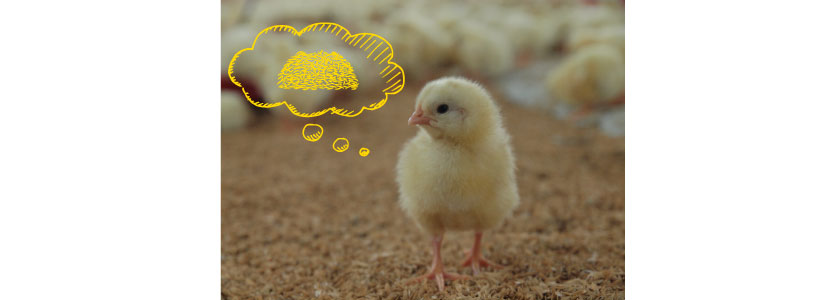Contenido disponible en: Español (Spanish)
Chick hatching is a critical point in broiler production. Due to its immaturity, it requires a rapid transition to achieve adequate tissue growth and higher yield. This implies supplying sufficient nutrients to ensure the development of the cardiovascular, musculoskeletal, pulmonary, digestive, and immune systems.
The day-old chick has the yolk sac attached to the intestine through the umbilical cord, which contains enough nutrients (carbohydrates, lipids, proteins, maternal antibodies, vitamins, minerals, and water) to make it self-sufficient initially. However, this union is only maintained during the first 48 h after birth, showing the depletion of the yolk sac with the presence of Meckel’s diverticulum in the post-mortem examination. The presence of an unabsorbed yolk sac is attributed to poor management and/or infection.
Initially, the lipids of the yolk constitute the only energy source of the chick, being the priority to achieve a successful transition from the endogenous energy source (yolk) to an exogenous energy source, which will be the carbohydrates of the feed during the first 72-96 h.
- The chick develops an appetite during the first 72-96 h of life.
- Chicks that do not develop a good appetite during this period of time will have slower feed intake during later growth, thus never reaching their optimal growth potential.
- Temperature and ventilation are important during the first days of growth.
Feed consumption stimulation
We have to bear in mind that, at first, the chicks do not know that the starter feed is food. They only have an instinctive pecking behavior towards interesting particles, such as coarse particles (ex: any object that forms a shadow), which can be feed particles if the rearing conditions are satisfactory, or chips if the feeding space is insufficient.
The secret of success is to provide sufficient feeding space in the rearing area (at least 50% of the total rearing area), covering it with white paper with a minimum of 75 g of starter feed per chick, in the form of a crumb ( 1-2 mm diameter) to stimulate pecking from the first day.
Placing white paper with feed crumbs to attract chicks
Chicks develop their appetite when they consume enough ‘interesting stuff,’ which occurs when their crop is full of feed and water, allowing for the digestion and absorption of nutrients. They reach sufficient plasma levels to stimulate the center of the body appetite of the brain. This occurs at 30 h after consuming the feed, that is, when the crop is full (Table 1).
Table 1. Crop filling after chick entry. Chick crop filling measured in a group of 100 chicks after introduction into the hatchery.
At this time, the chicks identify the feed as food.
It is also important to remember that chickens prefer to eat and drink in the company of their peers, which explains why they perform better in a group.
Water consumption stimulation
Young chicks consume more water with respect
Keep up to date with our newsletters
Receive the magazine for free in digital version
REGISTRATION
ACCESS
YOUR ACCOUNT
LOGIN
Lost your password?

